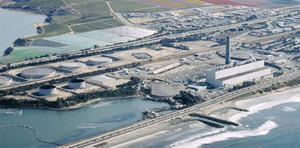WaterThe Western hemisphere’s largest seawater desalination plant to be built in California
The San Diego County Water Authority announced plans to build the Western hemisphere’s largest seawater desalination plant; the plant will produce fifty million gallons of fresh water per day, enough to supply about 7 percent of the San Diego region in 2020

Site of the proposed San Diego desalination plant at Carlsbad, CA // Source: peakwater.org
The San Diego County Water Authorityannounced last Thursday that it had reached an agreement to buy what will be the Western hemisphere’s largest seawater desalination plant.
The plant, located in Carlsbad, California will produce fifty million gallons of fresh water per day, enough to supply about 7 percent of the San Diego region in 2020.
The Huffington Post reports that the agreement still needs to be approved by the water authority board. If the board approves the sale, Stamford, Connecticut-based Poseidon Resources LLCwould sell bonds to finance 82 percent of the project which will cost an estimated $900 million.
Under the agreement, San Diego will pay $2,042 to $2,290 for an acre-foot of water, nearly all of it to Poseidon. This is more than twice what it currently pays to buy water from outside the region. Supporters of the project do not mind the excessive price tag as it will ensure the region is less dependent on water from the Los Angeles-based Metropolitan Water District of Southern California which has supplied water to San Diego since the early 1990’s.
“The story of San Diego has always been about the quest for reliable water,” Dennis Cushman, the San Diego agency’s assistant general manager told the AP. “The history is drought and water supply shortage and being subject to decisions made by a board of directors in downtown Los Angeles … This is about water reliability.”
The water authority says the average household bill in San Diego will increase about five to seven dollars per month once deliveries begin, and it estimates the cost to be comparable to other forms of drinking water, such as treated toilet water and briny groundwater.
Poseidon ran into problems at its desalination plant in Tampa, Florida as cost overruns and delays held up the project, but Ken Weinberg, the San Diego agency’s water resources director, is confident that the company has learned from the experience.
“In the front of our minds was to Tampa-proof this project,” Weinberg told the AP.
Water desalination technology has been an important source of fresh water in dry countries with long coast lines, but the technology has a downside: the bulky plants disrupt coastal landscapes, require massive amounts of energy, and release millions of gallons of brine back into the ocean, which must be properly treated or they will affect the local wildlife.
The Post quotes Tom Pankratz, editor of Water Desalination Report, to say that “The (Carlsbad) project will be somewhat of a bellwether or indicator of how desalination progresses in the U.S….. Some say it will be the last one. Others say the dam will burst and the floodgates are open.”
